The Major, or Motoko Kusanagi, is the protagonist of each incarnation of the Ghost in the Shell manga-anime-merchadise franchise. If you care to google, Motoko Kusanagi is autocompletes to “a man” and “is hot,” then “in bed with a boy” and “in bed.” For a science-fiction philosophy character named for her military position, we (the audience — although I don’t limit this to those who have experienced the fiction, as the Major is iconic) sure are caught up in thinking about her gender and sexual status. This is part 2 of a pan-franchise series (find part one here).
 Innocence, Mamoru Oshii’s 2004 optional sequel to Ghost in the Shell, sees the evolved Major in a far more rudimentary body. The swivelling ball of her lower torso is unmasked, her joints all visible, and she’s a largely silent presence. She signifies a more gynaecological interest in a woman’s, or girl’s, body.
Innocence, Mamoru Oshii’s 2004 optional sequel to Ghost in the Shell, sees the evolved Major in a far more rudimentary body. The swivelling ball of her lower torso is unmasked, her joints all visible, and she’s a largely silent presence. She signifies a more gynaecological interest in a woman’s, or girl’s, body.
The theatrical poster for the film shows her body naked and penetrated by various wires, again, but this time her body is without her — dismembered and discarded.
 The visual research for this film included a world tour of doll museums, leading to a concentration on the doll crafts of Hans Bellmer — widely regarded by adult male-led art scenes as an erotic artist — whose work drew heavily from the concept of sexual adolescence. As wikipedia has it, “Bellmer’s work was welcomed in the Parisian art culture of the time, especially the Surrealists around André Breton, because of the references to female beauty and the sexualization of the youthful form.” As read secondhand in Livia Monnet’s Anatomy of Permutational Desire, Part II: Bellmer’s Dolls and Oshii’s Gynoids, Oshii’s published notebooks reveal that “[b]eholding the actual Doll model, Oshii confesses that he felt as if he were being reunited with a woman whom he had secretly worshipped and desired in his youth, knowing full well that he would never meet her.” The sexualised child-woman mixture existed as a desirable or fascinating concept for Oshii before it became the primary aesthetic of the film’s driving force: a crime story, which focusses on the implantation of children’s awarenesses into sex-service robots modelled to resemble adult women.
The visual research for this film included a world tour of doll museums, leading to a concentration on the doll crafts of Hans Bellmer — widely regarded by adult male-led art scenes as an erotic artist — whose work drew heavily from the concept of sexual adolescence. As wikipedia has it, “Bellmer’s work was welcomed in the Parisian art culture of the time, especially the Surrealists around André Breton, because of the references to female beauty and the sexualization of the youthful form.” As read secondhand in Livia Monnet’s Anatomy of Permutational Desire, Part II: Bellmer’s Dolls and Oshii’s Gynoids, Oshii’s published notebooks reveal that “[b]eholding the actual Doll model, Oshii confesses that he felt as if he were being reunited with a woman whom he had secretly worshipped and desired in his youth, knowing full well that he would never meet her.” The sexualised child-woman mixture existed as a desirable or fascinating concept for Oshii before it became the primary aesthetic of the film’s driving force: a crime story, which focusses on the implantation of children’s awarenesses into sex-service robots modelled to resemble adult women.
Above right: HANS BELLMER Doll 1936 (cast in 1965). Below, a gif of a scene in which an AI (later revealed to be a child forcibly implanted into a prosthetic body that resembles adulthood, subsequently sold as a sex device) self-destructs after murdering her owner.
I can think only of men who think they “don’t understand women,” and want to take them apart until they find … what? “Find out.” Are these men fictional? I don’t understand how much this film is about male sexual entitlement and how much it is of it.
 The major’s ball-jointed, overtly manufactured appearance may critique the application of an adult body and intimate exploitation of a child’s psyche; it may apply the same exploitation to her in the audience’s perception; it may do both. This film is less popular, less culturally seminal, harder to source stills from, and (this feels critical to me) less cosplayed than Ghost in the Shell (1995) — or any other piece of the franchise. For example, it holds a Rotten Tomatoes 64% score to its predecessor’s 94%. Is this related to the Major’s relative dateable inaccessibility? Innocence presents her sexual status as ambivalent and unsettling, though many aspects of the presentation of her body to the audience are repeated, from the prior film.
The major’s ball-jointed, overtly manufactured appearance may critique the application of an adult body and intimate exploitation of a child’s psyche; it may apply the same exploitation to her in the audience’s perception; it may do both. This film is less popular, less culturally seminal, harder to source stills from, and (this feels critical to me) less cosplayed than Ghost in the Shell (1995) — or any other piece of the franchise. For example, it holds a Rotten Tomatoes 64% score to its predecessor’s 94%. Is this related to the Major’s relative dateable inaccessibility? Innocence presents her sexual status as ambivalent and unsettling, though many aspects of the presentation of her body to the audience are repeated, from the prior film.
 Batou again protectively, or possessively, places an oversized garment around her shoulders. This time it is sleeveless, bulky, and the absurdity is more obvious.
Batou again protectively, or possessively, places an oversized garment around her shoulders. This time it is sleeveless, bulky, and the absurdity is more obvious.
I adore Batou. He does not understand; he tries to be so kind. My first viewing of this film was almost entirely caught up in sympathising with Batou’s sadness — the Major’s status as post-individual disembodied lifeform alarmed me, and her presence as a Bellmer-style physicality registered, lightly, as repellant. I tried to ignore her. Her on-screen presence in the film is brief — she has only come back as a cameo, for Batou.


